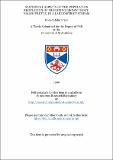Files in this item
Statistical aspects of the population regulation of migrating brown trout "Salmo trutta" in a Lake District stream
Item metadata
| dc.contributor.advisor | Cormack, R. M. (Richard Melville) | |
| dc.contributor.author | Fryer, Robert John | |
| dc.coverage.spatial | 241 p. | en_US |
| dc.date.accessioned | 2018-06-06T08:53:48Z | |
| dc.date.available | 2018-06-06T08:53:48Z | |
| dc.date.issued | 1990 | |
| dc.identifier.uri | https://hdl.handle.net/10023/13746 | |
| dc.description.abstract | Statistical aspects of the population regulation of a migratory brown trout population are investigated. The life cycle of the trout, the study area and the sampling routine are described in Chapter 1. Models of numerical changes in fish populations are reviewed in Chapter 2. Measures that assess the nonlinear behaviour of nonlinear regression models are described in Chapter 3. The additive error Ricker model describes the relationship between the number of 0+ parr in May/June and the number of eggs. The nonlinear behaviour of the model is investigated in Chapter 4. The parameter effects nonlinearity of the model is reduced by a reparameterisation. Chapter 5 investigates the effect of errors in the egg variable on the distributions of the least squares estimators of the additive error and the multiplicative error Ricker models. The errors-in-variables considerably increase the variances of the least squares estimators. Models of the relationships between the numbers of 0+ parr in August/September, the number of 1+ parr, the egg production of a year class and the number of eggs are developed in Chapter 6. These models account for the effect of summer drought on survival. Survival is density dependent during the first summer of the life cycle and density independent thereafter. Standard measures of nonlinearity can seriously underestimate the nonlinear behaviour of piecewise linear change-point models. New measures of nonlinearity appropriate for piecewise linear change-point models are developed in Chapter 7. Chapter 8 develops a model of the growth of brown trout fed on maximum rations as a function of time, body weight and water temperature. Chapter 9 develops a model that relates the survival rate of 0+ parr between May/June and August/September to the length distribution of the trout in May/June. The results of the Thesis are discussed in Chapter 10. | en_US |
| dc.language.iso | en | en_US |
| dc.publisher | University of St Andrews | en |
| dc.subject.lcc | QA276.8F8 | |
| dc.subject.lcsh | Estimation theory | en |
| dc.title | Statistical aspects of the population regulation of migrating brown trout "Salmo trutta" in a Lake District stream | en_US |
| dc.type | Thesis | en_US |
| dc.contributor.sponsor | Natural Environment Research Council (NERC) | en_US |
| dc.type.qualificationlevel | Doctoral | en_US |
| dc.type.qualificationname | PhD Doctor of Philosophy | en_US |
| dc.publisher.institution | The University of St Andrews | en_US |
This item appears in the following Collection(s)
Items in the St Andrews Research Repository are protected by copyright, with all rights reserved, unless otherwise indicated.

